Chapter 7
How to Hunt Ducks and Geese
Present restrictions make duck and goose hunting much more difficult than it was a few years ago when you could use live decoys.
For ducks I recommend a 3 shot 12 gauge Automatic Shot Gun. Use a long range load with number 4 shot.
I use about fourteen removable head decoys. Make your set about 100 yards off a point of land in an open spot with grass enough around so that you can scull quite close without ducks seeing you. When you see birds coming keep very still until they light in. Lay very low in your gunning float until you are within range. Don’t try to kill the whole flock. Pick out the nearest duck and stay with it until it drops before trying for a second bird. Go where wild rice is plentiful if possible and get your decoys out by daylight. The Federal law now allows shooting one-half hour before sunrise to one hour before sunset.
BILL GORMAN > The use of live decoys was outlawed in the forties. Hunters would trap a duck and strap a weight to its leg so it couldn’t take off. Its calls would attract other ducks. The modern-day version is the battery-operated decoy that flaps its wings or floats tail up, stirring up the water. The battery-operated decoy should be used with a spread of cork decoys.
If you are obliged to hunt where there is no grass or wild rice, construct a blind of boughs, old brush or other natural objects just out of reach of high tide and set your decoys within easy shooting distance. Keep all of your belongings out of sight so that your blind will look natural. Cover your boat with seaweed if possible or beach it where it will not be conspicuous.
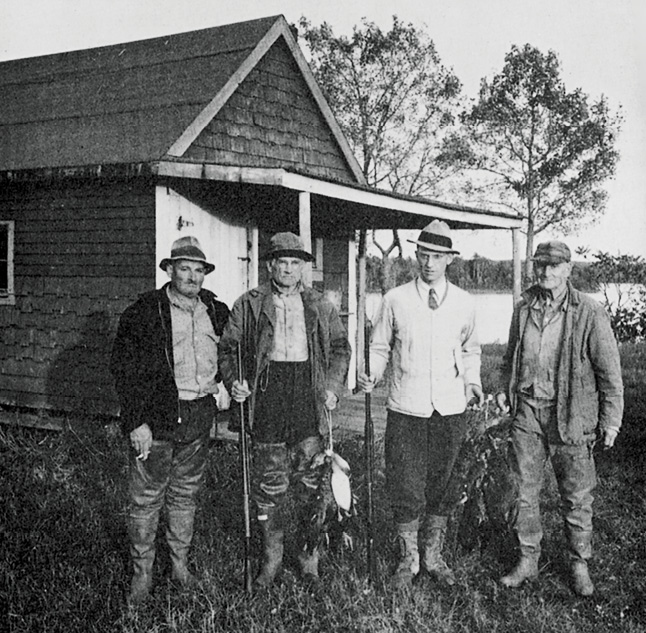
A guide, L.T. Patterson, the author’s son, Warren Bean and guide with a nice bag of Black Duck shot at Merrymeeting Bay, Maine (left to right).
Ducks should be cleaned immediately after they are shot. Remember what the little woman had to say the last time you cleaned a duck in the kitchen sink. Wipe the inside dry and hang by the neck.
Goose hunting is so difficult that you can not expect success without a guide.
BILL GORMAN > Today, few hunters would call goose hunting a “guide-only” sport. Canada goose populations have gone from being on the brink of extinction in parts of North America to abundance, thanks to habitat restoration. In some places, their recovery has been almost too successful, leading to complaints about nuisance birds.
There are two very important things you should attend to before you start hunting either ducks or geese and that is: 1st. Learn to hit a flying target. If there is no trap shooting field where you can go, get an inexpensive hand trap and practice with your duck gun until you can break about 50%. 2nd. Your cap, coat, pants and boots should blend with the duck marsh surroundings. I recommend olive green or khaki.
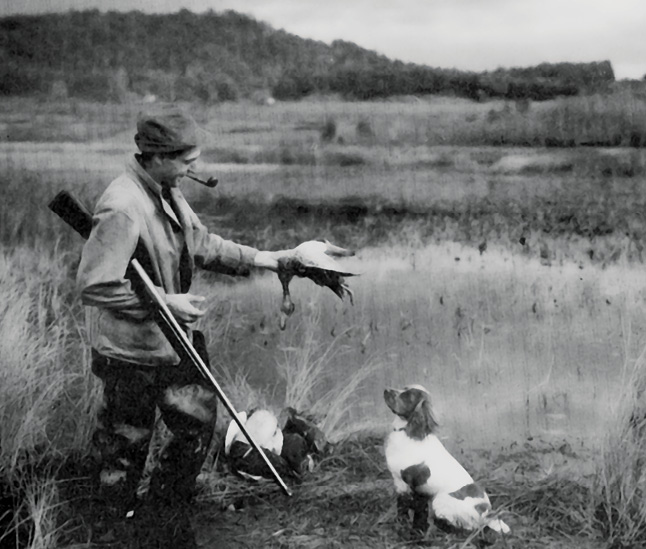
A good dog comes in handy to retrieve your ducks.
Unless you learn to hit a flying target you are very apt to stop your gun on a flying duck and shoot way behind it. I have been with good hunters, before live decoys were prohibited, who had good chances all day long without killing a single duck.
(Always keep in mind the safety rules in Chapter 13.)
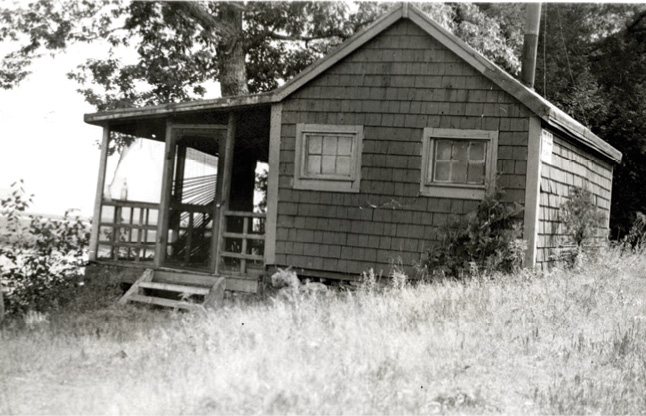
L.L. Bean’s Duck Hunting Camp at Merrymeeting Bay near Brunswick, Maine.
BILL GORMAN: This camp on Merrymeeting Bay in Bowdoinham was just 12 x 20 feet or so, with a kitchen and a combined living room-bedroom. It was one of several cabins owned by L.L. He called them all the Dew Drop Inn.
Hunting opportunities for turkeys in Maine are increasing annually, thanks to the efforts of wildlife managers and sportsmen. In just over three decades, Maine’s turkey population has gone from near zero to about 60,000 birds, and the birds are found in well over half the state. The heaviest concentrations of turkeys are in southern coastal areas and in Waldo County, where they breed in oak and beech stands and are often seen grazing in grassy pastures with their young. They are especially common around dairy farms because they like the feed corn they can easily find there.
Adult male turkeys are known as “gobblers” or “toms,” and juveniles are called “jakes.” You can easily identify males, as they are the birds that gobble and have spurs. All males have beards (clusters of hairlike feathers) growing out of the center of their chests, and during courtship, males’ heads often display vivid red, white, and blue coloration. Some hens have beards as well, but hunters are discouraged from shooting these older and experienced nesters. The spring hunt is for bearded turkeys only.
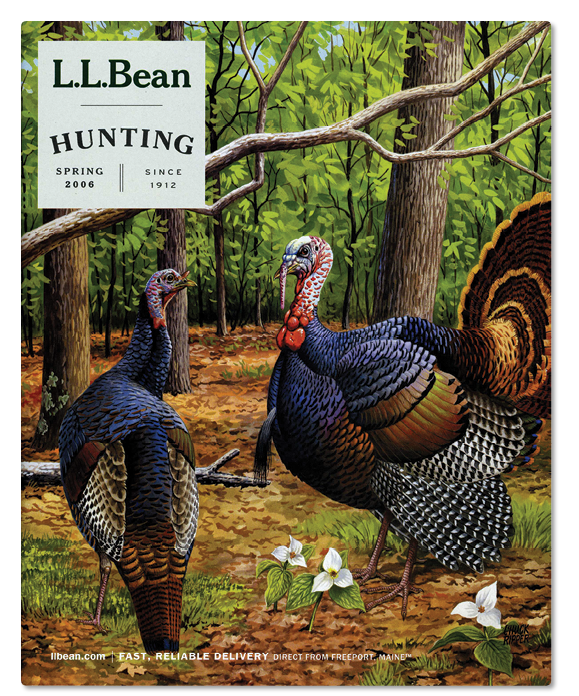
You can sit and wait for turkeys in areas where you’ve seen them before, but the best strategy is mimicking calls to attract lovesick gobblers. The most successful “turkey talk” is the hen yelp. Other useful calls include clucks, cackles, putts, purrs, and aggressive cutting. There is no better way to learn these sounds than to get into the woods and listen to the real thing.
In addition to learning to call, it is a good idea to scout before the season to try to locate as many different turkeys and promising hunting areas as possible.
Also, remember that turkeys have excellent hearing and eyesight — and that they can see color. You’ll want to wear complete camouflage and move as little as possible when setting up and calling.
Hunters get a second opportunity at turkeys of either sex in the fall. You are usually hunting either large flocks of hens and their young or bachelor groups of toms. At this time of year the birds are not responding to mating calls, and your strategy should be to scatter a flock and then try to call the birds back together. If you bust up a flock of hens and young birds, the most productive call is the kee-kee, which is basically a high-pitched whistle.
If you take a mature gobbler in the fall, it’s a true trophy. Come to think of it, with all of the effort and skill that go into turkey hunting, any bird taken in the spring or fall is one to be proud of.
— Bill Gorman
Handcrafted and realistically painted cork waterfowl decoys are an L.L.Bean tradition that dates back to one morning in 1935 when L.L. grabbed his friend and employee, George Soule, and said, “Let’s go duck hunting.” After several frustrating hours spent watching black ducks flare away from L.L.’s round-bottom wooden decoys, Soule pronounced them “a mess.” L.L. challenged Soule to make something better, and, using insulation cork from a junked refrigeration truck, he did. In fact, Soule’s decoys proved so effective at drawing in ducks that 2012 marks the seventy-fifth year that L.L.Bean has included them in its hunting catalog. L.L.Bean cork decoys are made on the same eight-spindle carving machine that George Soule used when, with L.L.’s blessing, he established his own decoy-making shop, first on the second floor of the L.L.Bean factory store and later in a separate building overlooking Casco Bay in Freeport. The machine traces one of Soule’s original hardwood masters (dozens of them are still in use), carving eight bird bodies at a time out of Portuguese black cork. The pine heads are carved two per spindle (that is, sixteen at a time) on the same machine. The keel also is pine, the tail is pine plywood, and the eyes are glass. A flat, no-shine paint is sprayed on, and field markings — in the case of black ducks, the blue wing feathers and olive or mustard bill — are painted by hand.
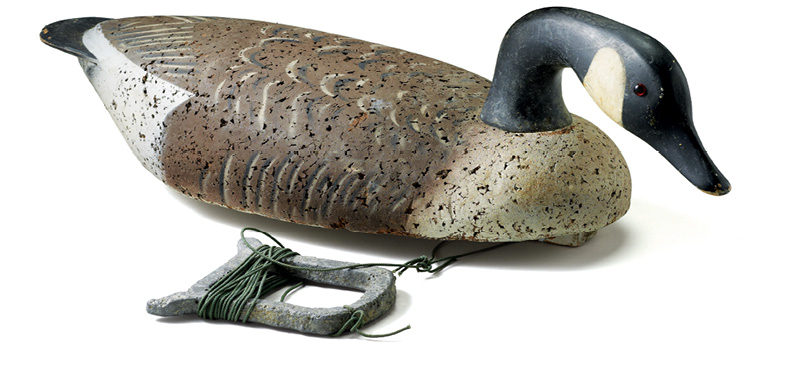
Soule, who died in 1996 at the age of eighty-four, is legendary for his “magnums,” larger than life-size black duck decoys that have been used by hunters with uncanny success to draw in the real thing. Soule theorized that the big decoys were simply easier for the ducks to see. They also were realistic in their appearance and, equally important, their movement, a direct result of the cork whose use Soule pioneered.
— Bill Gorman